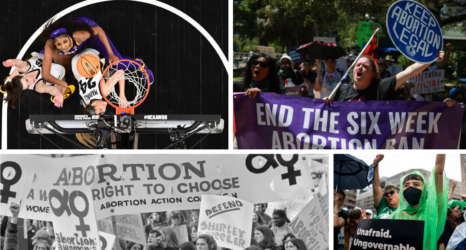One thing COVID-19 hasn’t changed are the challenges that women over 40 face when it comes to seeking jobs.

As COVID-19 upended the world, work at home moved from theory to reality. Yet, crushed by the load of caregiving and new responsibilities—whom, we should ask, were the ones sewing masks at their kitchen tables to keep their friends and families safe?—many of the same women who had long been advocating for telework and more flexible schedules found themselves left behind by an ecosystem that consistently devalues their contributions.
As vaccination rates and the degree to which businesses have opened up vary a great deal from state to state, it feels premature to frame the employment landscape as truly post-COVID. We don’t know what the longer range economic impacts will be—but we do know the pandemic was catastrophic for women. One thing that hasn’t changed are the challenges that women over 40 face when it comes to seeking jobs.
“I took my college graduation dates off of my resume, and I deleted a great deal of my past work history,” said Jenny Pritchett, 44, who changed jobs during the pandemic. A skilled senior writer who is also the author of a popular book on parenting, Pritchett worried that detailing out all of her experience would brand her as either expensive or old—traits clearly not deemed desirable by companies. “There was one interview where I knew my skills were aligned, but I talked about being a parent to a young kid, and when they declined my application their reason was that I ‘wasn’t a fit,’” she said.
Pritchett wondered if she’d run up against maternal wall bias. If she had not mentioned her child, might she have gotten an offer? It’s often assumed that children are women’s first priority, whether this has bearing on the position or not. Though she ultimately landed a new role, it took seven months, which is longer than average.
While technically all workers are protected against age discrimination in the workplace by the Age Discrimination in Employment Act of 1967, proving that age is the mitigating factor is difficult to prove, whether that is not being hired in the first place, or being pushed out later on. The pandemic only cemented ideas about where women’s place is, as the very fragile balance of school, daycare and partner support that women had relied on to pursue employment collapsed and sent many back home.
As Helaine Olen wrote for the Washington Post, “the pandemic … reminded everyone that women will sacrifice their own professional future and emotional well-being to take care of their loved ones.” Put aging in the mix, and it’s a double-whammy for women who want to earn.
Speaking to the struggle of job seeking, Sara Aiken asked, “How often do people really listen to their parents?” A sports management professional in her 60s who wants to stay in her industry, Aiken is faced with hiring managers who are often two decades her junior. While she believes that labor shortages precipitated by COVID have made some companies more open to considering workers like her, a stigma definitely exists.
“I remind someone of their mom or even their grandma in an interview,” she said. “They don’t care about what I have to say.”
Compounding the issue is that the location flexibility that was critical to keeping workers safe at home but businesses operational is eroding, with some tech giants like Apple leading the charge to get workers back in the office in what will likely be a massive loss for workplace inclusivity. At the same time, a study published by Bloomberg in March noted that “closing labor-market gender gaps is crucial for the economy” both globally and in the U.S., and calls out flexibility as a key to improve labor participation for women.
It’s often those female workers over 40—or nearing middle age—who need flexibility the most. The sandwich generation, women who are caring for both children and parents, carry a massive emotional load and can also be important contributors to household income. Despite the deep hiring prejudices they face, labor market productivity actually tends to rise for women as they age.
“I spent six years of working reduced hours so I could be available as a parent to my daughter,” said a 41-year-old married woman who preferred to remain anonymous. She had planned to grow her practice when her daughter entered kindergarten, but as lockdown hit, she had a new, unpaid full time job: Zoom school attendant. Now, as she resumes a job search, though she holds a master’s degree, the nearly half a decade of lost salary and career progression weighs heavily. “The care infrastructure in my household is basically just me,” she said. “If I can scale up, I wonder how that will work while my daughter is still young.”
“Women across age ranges are often locked into low-wage jobs, and as they grow older, it becomes even harder and harder to access employment that is more meaningful to them financially.”
The June jobs report from the Bureau of Labor Statistics shows that unemployment for men is actually slightly higher at 5.9 percent than that of women at 5.5 percent. Yet, this same report shows a whopping 474 percent increase in the number of job leavers—that is, people who are now unemployed after voluntarily leaving a job. Alongside of that number is a 2.2 percent decrease in telework. While the job leavers data does not report how this is distributed by gender identity, we do know that women’s labor participation rates have been driven to lows not seen since the 1980s, suggesting that women do in fact comprise many of these job leavers.
“So many women are underemployed, including those who are working full time,” said Gina Avila, the founder of the Women’s Empowerment Institute, a nonprofit that offers underserved women personal, professional development, mentorship and job skills training. “Women across age ranges are often locked into low-wage jobs, and as they grow older, it becomes even harder and harder to access employment that is more meaningful to them financially. The challenges are very real and very intense,” said Avila.
The picture that emerges is a telling one. The barriers to workforce participation that women and female-identifying people have always faced remains persistent. COVID-19 has erased many gains made by women in the workplace, and the pandemic promise of flexibility now feels like yet another promotion we were passed over for. The Bloomberg study above cites data that shows women could offer a $20 trillion boost to global economic growth by 2050. In almost any other model, it feels like employers would want to capitalize on such an opportunity.
Is the power of a corporate balance sheet enough to overcome hiring bias?
Ask women over 40.
Up next:





